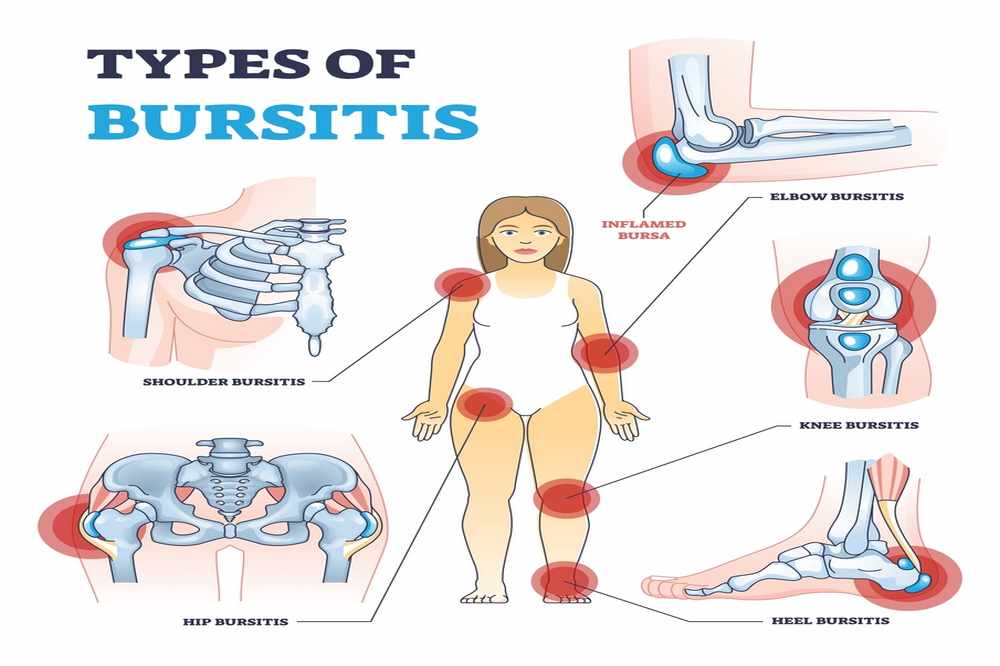Types Of Bursitis

There are several different types of bursitis, each with its own unique symptoms and causes. (4)
Shoulder bursitis
The most common type of bursitis is shoulder bursitis, which is caused by inflammation of the bursa located in the shoulder joint. The shoulder is a common site for bursitis, as the shoulder joint is subjected to a great deal of wear and tear. Bursitis can occur due to an infection, injury, or overuse. Symptoms of shoulder bursitis include pain, swelling, warmth, and redness in the affected area. This type of bursitis can cause pain and stiffness in the shoulder, as well as difficulty moving the arm.
Retromalleolar tendon bursitis
Retromalleolar tendon bursitis is a condition that affects the back of the ankle. The condition is caused by inflammation of the retromalleolar tendon bursa, which is a small, fluid-filled sac that separates the Achilles tendon from the bone. This type of bursitis is most often caused by an injury to the ankle or foot. Symptoms of retromalleolar tendon bursitis include pain, swelling, and stiffness in the back of the ankle. Treatment for this condition typically includes rest, ice therapy, and NSAIDs. In some cases, surgical intervention may become necessary to remove the inflamed bursa.
Posterior Achilles tendon bursitis
Achilles tendon bursitis is a common condition that results in inflammation of the bursa located behind the Achilles tendon. The bursa is a sac (fluid-filled) that acts as a cushion between the Achilles tendon and the skin. Bursitis can occur when the bursa becomes irritated or inflamed. This may be due to overuse, trauma, or infection. Posterior Achilles tendon bursitis is a specific type of Achilles tendon bursitis that occurs at the back of the ankle. Symptoms include pain and swelling behind the ankle, particularly after exercise. Treatment typically involves rest, ice, and anti-inflammatory medications.
Hip bursitis
The hip joint is a ball-and-socket joint. The head of the femur (thigh bone) rests in a depression called the acetabulum in the pelvis. A small fluid-filled sac, called a bursa, sits between the femoral head and the acetabulum to reduce friction and allow smooth movement. When this bursa becomes inflamed due to any cause, it is called hip bursitis.
Hip bursitis may be caused by a direct blow to the hip, overuse (such as from running or jumping), arthritis, and infection. It may cause pain and swelling in the hip. You may have difficulty walking or rotating your hip.
Elbow bursitis
It is a condition that develops when the bursa, or fluid-filled sac, located in the elbow joint becomes inflamed. This bursa helps to cushion and lubricate the elbow joint, and when it becomes irritated or inflamed, movement on the forearm can be painful.
Elbow bursitis is most often caused by overuse of the elbow joint, such as from repetitive motions like typing or using a screwdriver. Other causes can include trauma to the area, infection, or rheumatoid arthritis. Symptoms of elbow bursitis include pain, swelling, and stiffness in the elbow joint. Treatment for elbow bursitis typically includes rest, ice therapy, and NSAIDS to help reduce inflammation.
Knee bursitis
Knee bursitis is a form of bursitis that affects the knee joint. The most common symptom of knee bursitis is pain and swelling around the kneecap. This can also cause pain as well as difficulty bending the knee. Other symptoms may include warmth and redness around the affected area, stiffness, and difficulty walking or using the leg.
Knee bursitis is often caused by overuse or repetitive motions, such as kneeling or squatting. It can also be caused by an infection, arthritis, or trauma to the knee. Treatment for knee bursitis typically involves resting the joint, applying ice packs to the area, and taking anti-inflammatory medications such as ibuprofen.
